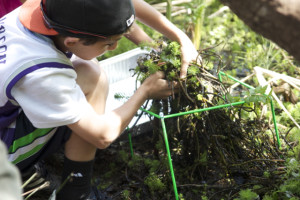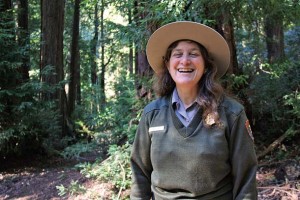A discovery pack is a simple tool that can greatly enhance your study of nature. A well-stocked pack will fit in with any field trip, whether to the beach, desert, forest, city neighborhood, vacant lot, park, or even grandma’s house for dinner. Using your skills of observation, questioning, and comparing, you can learn a lot about the world around you—and have a lot of fun!
Here’s what you need:
Day Pack – Recycle one from home, or buy one at a second-hand store, flea market, or garage sale. Try to find one with a number of pockets and pouches. Be sure it fits comfortably and the straps are padded, because everything else will go into it.
Plastic, closeable bags – good for collecting live creatures and holding them safely while you look at them. Can also hold water for tadpoles, aquatic insects, fish, etc. Have several sizes.
Envelopes – good for keeping seeds, leaf specimens.
Garden trowel – A must when digging for burrowing creatures, prying open rotting logs, flipping cow pies, etc.
Kitchen strainer – Use as a makeshift aquatic net for catching animals or grabbing floating plants.
Scissors – Use for snipping away vegetation from your field of view when taking close-up photos. Also useful for cutting string, dried plants, etc.
Small flashlight – Never again will you have to wonder if something is lurking in the dark cave, burrow, or hole. Can be used to spotlight objects in a forest, watch bugs at night, or signal to a friend.
Sharp pocket knife – There are innumerable uses for a pocket knife. Keep it sharp and lightweight. But be careful when you use it!
White pillow case – Lay it on the ground under a shrub or tree and tap the branches with a stick to see what insects and spiders are hiding in the vegetation and concealed among the leaves. Also useful as a place to rest your head while cloud watching!
Plastic trash bag – Need an instant rain parka, dry spot to sit, or litter bag? Try one of these multi-use bags.
Tweezers – Good for picking up delicate insects, leaves, twigs; feeding spiders; removing splinters; etc.
12″ x 18″ aluminum foil – Makes a great light reflector when taking pictures of flowers, ferns, spider webs, mushrooms, etc.
Mirror – Signal a group member, point out a tree across the canyon, bounce light into a burrow.
Plastic ruler – A 6-inch ruler with both metric and inch scale is handy for comparing sizes and measuring leaves, insects, and anything else you come across.
Toilet paper – A fist-size roll will prepare you for those unexpected emergencies, but you can also use some to clean out wounds, wrap delicate objects you want to save, or start a fire in an emergency (be very careful with that last option!).
Waterproof matches – be prepared!
Assorted band-aids – Nothing stops tears faster than a band-aid.
Rubber bands – Good for bundling dry grasses, branches, cattails for transport, attaching bagged insects to their host plant, etc.
String – A length of heavy string has hundreds of uses on the trail, from suspending a thermometer into a pond or creek to lashing driftwood branches into a quick shelter, repairing your walking stick, or tying things to your pack.
Paint brush – A small craft or hobby paintbrush is a good tool for dusting debris out of an animal track, collecting pollen grains, or triggering a spider into action in its web.
Old toothbrush – These stiff bristle brushes are great for cleaning dirt out of sea shells, bones, nuts, bark fragments, and rocks.
12″ x 12″ nylon netting – Useful for keeping live specimens in a container for studying. Can also be used to sift fine soil, sand.
Assorted plastic containers – pill bottles, small food containers, and re-useable plastic boxes are sturdy devices to use for watching small creatures, protecting fragile objects, or passing around delicate specimens.
Pliers – Good to crack open nuts or to flip over a dead animal to see what scavengers are living underneath. Whenever possible, put objects back where you found them.
Lifesavers Candy – Great little pick-me-up after being on the trail for a couple hours. Moistens mouth in hot dry climates.
Notepad and pencil – Indispensable for recording your observations, making tree bark rubbings, sketching subjects, making your own trail map, etc.
Whistle – You may need it for safety, so carry a non-breakable model.
Here are some less essential items you may want to purchase to make your discovery pack into a complete field kit:
Hand lens – A good 10x pocket magnifier will open up a new world to you. Insects, moss, crystals, lichens, flowers, feathers, and mushrooms are only a few of the hundreds of things a hand lens will allow you to see in fine detail. Can also be used to start a fire in an emergency.
Compass – If you are experienced with map reading and feel comfortable with a compass, you will find there is much more life away from well-traveled roads and trails. Please be careful if you leave the trail; it can be dangerous!
Assorted field guides – Although they can be weighty, a collection of local guides to birds, flowers, insects, and trees will help you identify those mysterious creatures and plants out there.
Binoculars – a necessary item if you are interested in birds, but not required to enjoy nature. Newer close-focus models are ideal for butterfly and insect watching, too.
Camera – a pocket digital camera or point-and-shoot film camera will allow you to make a permanent record of your outings.
With the exception of the last five items, a discovery pack can be put together with common household supplies. We all have these items in our junk drawers, in the garage, or lying around collecting dust at work. Make building your kit a family project and then store the bag in the car, so whenever you’re out and about, you’ll have the pack right at hand!
[Editor’s note: Keep in mind that many parks and open spaces don’t allow collection of any materials from their lands. If traveling off trail, be careful not to disturb fragile soils or plants. And watch out for poison oak! Wherever you go, check into park rules, and we encourage you to explore and learn, but also to use your discovery pack wisely and leave as many things as possible as you find them. That way, the next explorer can find them and learn from them just like you did!]




